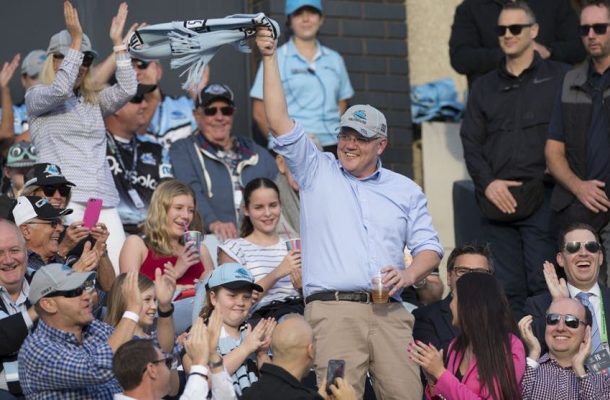Scott Morrison’s spectacular win, against all expectations, is attributable to a potent mix of his strengths and Labor’s weaknesses.
Morrison, it turns out, was made in some political heaven where they forge ideal campaigners. This man of faith may well literally believe in miracles, which is an advantage when you’re in a tight corner. Certainly he’s swallowed the book on the power of positive thinking.
He was determined, focused, and John Howard’s successor in talking to the battlers. He brought marketing and tactical skills to the task.
But given the shambolic Coalition performance of the last two terms, he couldn’t have won if Labor hadn’t left itself exposed.
The opposition’s weaknesses are magnified in retrospect. The voters were wary of Bill Shorten. Labor was carrying too much policy weight. And it did not crystallise its messages into one compelling, cut-through theme.
In contrast, Morrison successfully hammered economic management as the facilitator of everything else people wanted, such as spending on health, education, and the NDIS.
Cost of living was a Labor issue but by the campaign’s end, the government had people worried Labor’s tax changes would add to that burden.
While climate change took Liberal votes in heartland areas, overall it didn’t deliver for Labor.
Mixed messaging over Adani was a drag in parts of Queensland. Labor polled only 22.7% in regional Queensland, and minor party preferences worked against it.
Labor over years tried to persuade itself voters’ unwillingness to embrace Shorten didn’t matter. The government had failed to “kill Bill”, and he had triumphed in the “Super Saturday” byelections. But in the ultimate test, his unpopularity was a drag.
Observers will lament that Saturday’s result shows it is impossible for an opposition to win with a robust change agenda. It might, however, be the case that just too much was piled into it.
To finance its big spending, Labor needed its crackdowns on both negative gearing and franking credit cash refunds. Each had losers. More modest changes might have survived the scare campaigns.
But Saturday’s result will reinforce the usual inclination of oppositions to be “small targets” (which can be followed by the voters getting nasty shocks when an opposition goes into government, as we saw with the 2014 budget).
Labor’s regrouping will involve both a new leader and repositioning on policy.
Long-time aspirant Anthony Albanese, from the left, has announced he’ll run for the leadership, which is decided by rank and file and caucus ballots. Deputy leader Tanya Plibersek, another leftwinger, has the support of Shorten for a tilt. Shadow treasurer Chris Bowen, from the right, is considering whether to contest; he carries the burden of being a driving force behind the rejected policy agenda.
There’d be a lot of sense in Labor jumping to the new generation and finance spokesman Jim Chalmers. Chalmers, from the right, is articulate, economically highly literate – and a Queenslander.
Precisely how Labor repositions will depend on who’s leader, and will take time to work out, but logic suggests that next election it will be pulled towards the centre with a less risky pitch.
Not least because that election will potentially be very winnable for the ALP. Whatever the Coalition’s final number in the House of Representatives, electorally it will be extremely vulnerable next time, just as it was this time.
And a note from History: Paul Keating won the unwinnable election in 1993 and lost in 1996.
Morrison gains immense authority from this victory, but in politics euphoria is a very perishable commodity. New rules protect the stability of the prime ministerial leadership, however Morrison’s standing in two years will be a function of how he handles the job from now, not what happened on Saturday.
His first challenge will be crafting a new ministry, and he has quite a lot of spots available. The reshuffle has to be substantial.
Morrison made much of having a record seven women in his cabinet; if he wants to keep up that number, it will require the elevation of a woman to replace Kelly O’Dwyer. Sussan Ley, most recently an assistant minister but once in cabinet, would seem an obvious contender.
Morrison has promised Linda Reynolds defence. He’s also said Melissa Price – notoriously in hiding most of the time – would remain environment minister. That would be a bad idea – we’ll see if he can get out of it.
Arthur Sinodinos, back from illness, should be in cabinet. Attorney-General Christian Porter is being talked of as leader of the house to replace Christopher Pyne, who retired at the election.
In policy terms Morrison is locked into little apart from the budget’s tax cuts. Parliament will be brought back quickly to deal with those; the question is whether the government can get the whole package, including tax relief for higher income earners in later years, through the Senate at that time.
Beyond this, we have minimal idea of what Morrison will make of the coming term. He’s said he’ll “burn” every day for Australians. He’s insisted he’ll call the shots within the party. What this means for policy is unclear.
Notably, will the ideological struggles erupt once again in the Liberal party and how will Morrison handle them? The disruptive power of Tony Abbott has been removed. But there remains a forceful right wing presence. And there are looming issues, such as protections for religious freedom and freedom of speech, that are divisive. It is also hard to believe the internal climate debate won’t continue, as the government has to manage the energy transition.
Morrison prides himself on his pragmatism. Sinodinos has pointed to a possible way of channelling that, suggesting the government should look to Robert Menzies’ course after his near-death experience in 1961, when he “pinched some opposition policies”. Sinodinos thinks Labor’s policies on cancer funding and pensioner dental care are worth considering.
Morrison has proved himself excellent at campaigning. We will find out this term how well he can govern.
This article was published by The Conservation.














